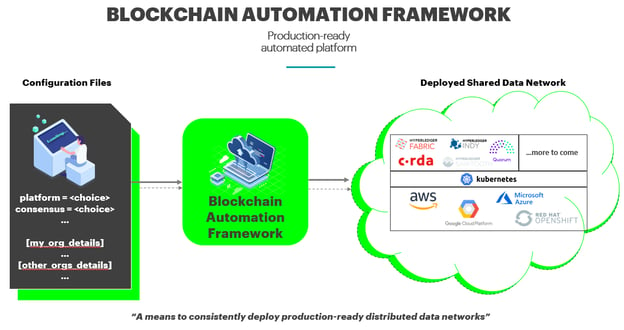How to quickly deploy blockchain networks that can scale to production With Blockchain Automation Framework, a Hyperledger Lab
One of the key deterrents in the adoption of blockchain/DLT today is that it is perceived as a complex technology, with a time-consuming network setup and operations. Accenture’s Future Systems research shows that, for companies across the world, the biggest barrier to innovation at scale is the ability to build flexible, uniform architectures capable of responding to market demands. This is in line with what we hear from our blockchain clients who want to know how to scale a blockchain trial to a production environment while safeguarding their investments.
The presence of a variety of enterprise DLT providers today such as Hyperledger Fabric, Hyperledger Indy, Hyperledger Besu, R3 Corda, Quorum and more, each with their own architecture and disparate services, compound the complexity in the world of DLT.
We get it. Getting started can be hard.
Setting up a new DLT network or maintaining an existing DLT network in a production-scale environment is not straightforward. For the existing DLT platforms, the steps in setting up one DLT network cannot be applied to others. When blockchain developers are asked to use an unfamiliar DLT platform, it requires a great deal of effort for even experienced technicians to properly setup the DLT network. This is especially true in large-scale production projects across multiple corporate environments more focused on other key aspects such as security and service availability.
Another problematic trend across many different organizations’ blockchain/DLT implementations is the PoC (Proof of Concept) first approach. While this is a sound way to test whether the technology can work, scalability and security are not part of the design at the outset, and so significant efforts are required to rearchitect and rebuild for production deployments.
Cloud vendors such as AWS and Azure offer managed blockchain services (aka Blockchain as a Service or BaaS) to help alleviate various pain points during the process of preparing a production-scale DLT network. However, these solutions have network size limitations, lock all nodes into a single cloud provider, or offer few choices for DLT platforms, which may be deal-breakers in some scenarios.
What if it didn’t have to be?
Imagine if the several weeks of development time required to set up and deploy a DLT network could be reduced to a matter of hours. What if the same framework developed for a PoC could scale to pilots and production, evolving along with the applied solution for faster innovation and more seamless innovation?
With these opportunities in mind, our team at Accenture Blockchain and Multiparty Systems started conceptualizing “Blockchain Automation Framework.” BAF helps developers rapidly set up and deploy secure, scalable and production-ready solutions that also allow new organizations to be easily onboarded on the network. BAF accelerates delivery and lets developers focus on building blockchain applications without having to waste precious time standing up the environment or worrying whether the network will scale and meet production requirements.
How does it work?
Using a single configuration file, you deploy the distributed network on a cloud infrastructure of your choice, including certificate management and smart contract installation. Whether developing an early stage PoC, late stage pilot, or scaling for production, Blockchain Automation Framework can reduce the time required to bring up the network from days to hours. The secure, fault tolerant framework helps to ease onboarding of new organizations and accelerate testing or production deployments in multicloud or multiparty systems.
 Here is a quick look at the components and features BAF uses to automate network deployment:
Here is a quick look at the components and features BAF uses to automate network deployment:
- Ansible playbooks and role definitions that follow a specific order to automate the entire DLT network setup
- HashiCorp Vaults to securely store tokens, passwords and certificates
- Kubernetes services, including Ambassador or HAProxy Ingress Controller, to route traffic and enable inter cluster communication
- GitOps method for continuous deployment to Kubernetes clusters via Flux operator
- Helm Charts for designing and configuring the architecture
- The ability to share a configured network.yaml file without disclosing any confidentiality
Learn more with this video overview of the Blockchain Automation Framework:
Collaborate with us!
We are actively searching for potential contributors, maintainers, and partners who understand the value of Blockchain Automation Framework and share the vision of building and owning well architected solutions. We wish to work with the Hyperledger community to identify the needs and requirements of other network operators and to further reduce the barriers in blockchain adoption. As we roll out new features and further DLT platform support, all are welcome and encouraged to collaborate with us and share their feedback. Check out the source code and documentation on GitHub and please do bring technical questions to our Chat channel or join our open BAF meetings.
